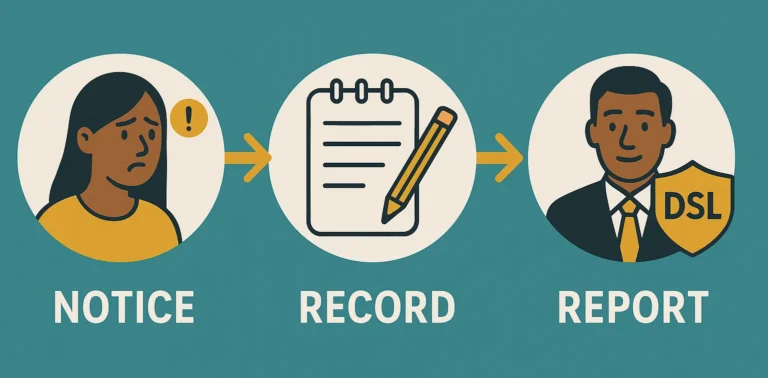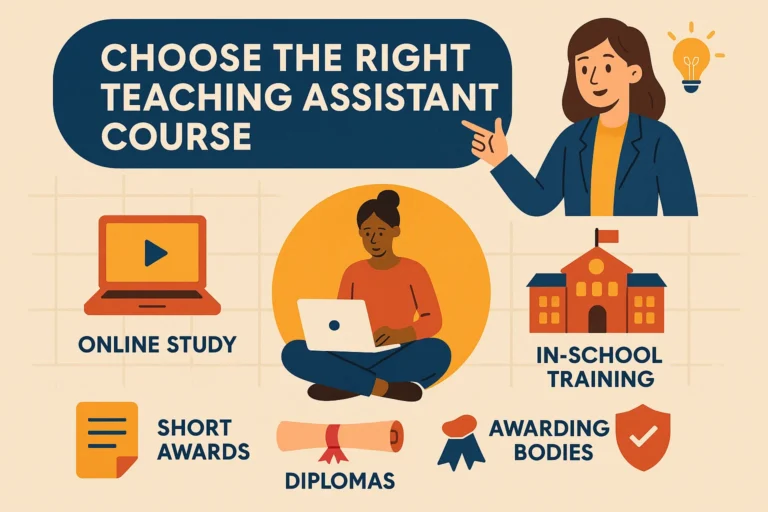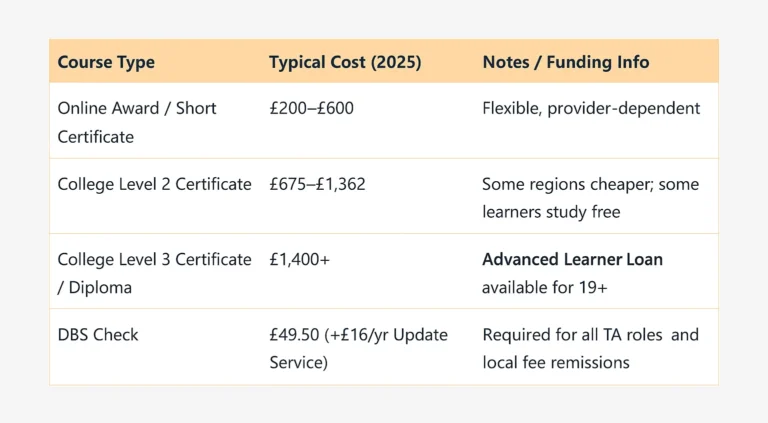If you love helping children learn and want to make a real difference in schools, becoming a teaching assistant could be the perfect career path for you. It’s one of the most rewarding jobs in education — and the good news is, training to get there is simpler than you might think. In this blog, we’ll walk you through how to train to be a teaching assistant in the UK — from choosing the right TA course Level 2 or Level 3 to completing your DBS check and securing that all-important school placement.
Whether you’re starting fresh or changing careers, you’ll learn exactly what qualifications you need, how to fund your training, and how to take your first confident step into the classroom.
So, if you’re ready to support pupils, work closely with teachers, and start a career that truly matters, this step-by-step guide is here to help you begin — calm, prepared, and inspired.
What Does a Teaching Assistant Do Day to Day?

If you’ve ever wondered what a typical day looks like for a teaching assistant, it’s a mix of structure, flexibility, and constant support. No two days are ever quite the same — but the goal is always the same: helping pupils learn and keeping the classroom running smoothly.
A big part of teaching assistant duties involves supporting the class teacher during lessons. You might help set up resources, check pupils’ understanding, or lead 1:1 or small-group activities in phonics, reading, or maths. Many TAs also play a vital role in SEN support, adapting work for pupils who need extra help or using visuals, timers, and sensory breaks to make learning more accessible.
Throughout the day, you’ll jot down quick progress notes — short, factual observations that help the teacher plan next steps. And underpinning everything you do is safeguarding. Following the KCSIE 2025 guidance means you’re alert to signs of concern and always act through the correct route: notice → record → report to the DSL (Designated Safeguarding Lead). It’s part of what makes you a trusted, professional member of the school team.
Being a teaching assistant is about connection, calm, and consistency. Every small action — a smile, a reminder, a quick bit of encouragement — helps children feel safe, confident, and ready to learn.
How to Train to Be a Teaching Assistant?
To become a TA, you don’t need a degree — but you do need the right mix of basic education and recognised qualifications. Here’s what most schools in the UK look for when hiring new teaching assistants:
Essential Requirements
- GCSEs or Functional Skills in English and Maths – Aim for grade 4 (C) or above. These show you can support literacy and numeracy in class.
- If you don’t already have these, you can take Functional Skills courses alongside your TA training.
Recommended TA Qualifications (UK)
- Level 2 Teaching Assistant Course (Certificate in Supporting Teaching and Learning):
- The ideal entry route for beginners. It introduces the basics of classroom support, safeguarding, and child development.
- Level 3 Supporting Teaching and Learning Diploma:
- Preferred by many schools for classroom roles. It offers deeper knowledge of SEN, behaviour management, and pupil progress.
Funding Options
- Learners aged 19+ can often access the Advanced Learner Loan to cover the cost of a Level 3 Supporting Teaching and Learning qualification.
- You can find approved training providers and funding details on GOV.UK.
If you’d like a full breakdown of exactly what qualifications, checks, and skills you’ll need, explore What Do You Need to Be a Teaching Assistant on Unified Course. It’s a clear, practical guide that explains every requirement — from DBS checks to CPD courses — and helps you plan your pathway with confidence.
How Do You Choose the Right TA Course?

Choosing the right teaching assistant course is the first real step toward building your classroom career. The best option depends on how you like to learn, how much time you can give, and whether you’re looking for flexible online study or practical experience in schools.
1. Online Courses (Award or Certificate)
If you need flexibility, an online TA course is a brilliant place to start. These courses focus on knowledge rather than classroom placement, letting you study from home and fit learning around your life. They’re usually shorter, more affordable, and great for building confidence before moving on to Level 2 or 3.
2. College Courses (Certificate or Diploma)
If you prefer hands-on learning, college-based qualifications combine theory with real classroom experience. You’ll gain practical skills through school placements, which makes these courses stronger for long-term career prospects. Diplomas, especially the Level 3 Supporting Teaching and Learning, carry the most weight with employers.
3. What to Look For
- Short Awards – quick to complete and perfect for beginners.
- Diplomas – more in-depth, recognised by schools nationwide.
- Awarding Bodies – choose trusted providers like CACHE, City & Guilds, or TQUK to ensure your qualification is respected.
4. The Smart Way to Start
If you’re ready to begin your journey, choose a provider that blends flexibility, affordability, and expert support. Unified Course offers exactly that — professional CPD and TA training that’s online, easy to access, and designed by educators who understand real classrooms. With unlimited learning opportunities and recognised certificates, it’s the simplest way to start strong and grow with confidence.
Do You Need a School Placement While Training?
Most teaching assistant courses include some form of school placement, but the exact requirement depends on the qualification. If you’re studying a Level 3 Diploma, you’ll usually need to be based in a school so an assessor can observe you working directly with pupils — it’s a vital part of proving your competence and confidence in the classroom.
For many Level 2 Certificates or shorter online Awards, placements aren’t always mandatory, but completing one can make a huge difference. Hands-on experience helps you apply what you’re learning, build strong references, and show real commitment to the role. Even a voluntary placement a few hours a week can boost your skills and employability. Before enrolling, always check the placement and observation requirements with your course provider so you know exactly what’s expected — and can get the most out of your training.
How Much Does It Cost to Train as a Teaching Assistant?

Can You Train Online to Be a Teaching Assistant?
Yes — you can absolutely complete a teaching assistant course online. Many providers now offer flexible, distance learning TA options where you study at your own pace with full tutor and email support. You’ll complete online assessments, and for any competence-based units, you may need to provide workplace evidence such as video observations, assessor visits, or supervisor witness statements — this varies by provider.
Online learning is ideal if you’re balancing study with work or family life, and it’s a great way to build confidence before stepping into the classroom. Platforms like Unified Course make this even easier by offering trusted, CPD-accredited TA courses designed for real school settings. You can learn from anywhere, get unlimited tutor guidance, and earn recognised certificates that show your progress and professionalism.
What Extra Training Helps You Stand Out?
Adding a few focused CPD courses can make your CV shine and show that you’re proactive about professional growth. These short modules are low-cost, easy to complete, and perfect for boosting confidence before or during your first TA role.
- Safeguarding Course – essential for every school role; shows awareness of pupil safety.
- Autism & ADHD Awareness – helps you understand diverse learning needs.
- Behaviour Management – practical strategies for calm, positive classrooms.
- Phonics & Reading Support – ideal for early years and literacy-focused roles.
- Emergency First Aid – valuable for pupil wellbeing and staff safety.
How Long Does It Take to Qualify as a Teaching Assistant?
How long it takes really depends on your course level, study pace, and whether you’re completing a placement at the same time. The good news is, you can qualify in under a year — even while working or caring for family.
- Short Online Awards: take just a few weeks to 3 months. They’re self-paced and perfect for beginners.
- Level 2 Certificate: usually 3–6 months, depending on how many hours you study each week.
- Level 3 Diploma: around 6–9 months or longer if your course includes classroom observations.
If you’re aiming for a school-based role, it’s worth allowing extra time for your placement and DBS check. Most learners find that steady, consistent study — even a few hours a week — keeps them progressing smoothly.
What Happens After You Qualify?
Once you’ve finished your training, you’re ready to start applying for teaching assistant jobs — and this is where your preparation pays off. You can find vacancies on school websites, local council job boards, and national platforms like TES, Indeed, and multi-academy trust (MAT) listings.
Before applying, make sure you have:
- A valid enhanced DBS check.
- References from your course or placement.
- Evidence of your qualification and any CPD certificates.
When interviewing, be ready to discuss how you’d handle safeguarding, behaviour, and SEN support. Reflecting on real examples from your course or placement will help you stand out.
You can start your job search through your local education portal, such as schools.norfolk.gov.uk, and apply confidently knowing you’ve built strong, relevant experience.
How Long Does It Take to Qualify as a Teaching Assistant?
The time it takes to become a qualified teaching assistant depends on your course level, how you study, and how much time you can dedicate each week. There’s no rush — many learners qualify while working, raising a family, or volunteering in schools. The key is to go at a steady pace that fits your life.
Here’s a rough guide to help you plan:
- Short Online Awards: These are quick, flexible courses that usually take a few weeks to 3 months. You can study whenever it suits you, with tutor support available if you need help.
- Level 2 Certificate: This takes around 3–6 months to complete. It covers the core skills of classroom support and often includes optional practical tasks or placements.
- Level 3 Diploma: The most in-depth qualification, usually taking 6–9 months (sometimes longer if you’re completing school placement hours). It gives you a deeper understanding of learning, behaviour, and SEN support — and it’s the most recognised by employers.
If your course includes a placement or assessor observation, allow a little extra time to gather evidence and complete feedback. Most learners find that studying a few hours a week consistently makes the whole process manageable and rewarding.
Tip: Don’t rush — steady progress builds stronger confidence and understanding.
What Happens After You Qualify?
Once you’ve completed your course — congratulations! You’re now ready to start applying for teaching assistant jobs. This is where your training, placement experience, and confidence really start to shine.
You can search for roles in a few key places:
- Local school websites and multi-academy trust (MAT) pages
- Council education job boards, such as schools.norfolk.gov.uk
- National platforms like TES, Indeed, and eTeach
Before applying, make sure you have everything you need:
- A valid enhanced DBS check (and sign up for the Update Service if possible).
- Strong references from your course or placement.
- Evidence of your qualifications and any CPD certificates you’ve earned.
When you’re invited to an interview, be ready to discuss:
- How would you handle safeguarding or behaviour concerns?
- What strategies do you use to support pupils with SEN or learning differences?
- How you communicate with teachers and other staff.
If you’re nervous, that’s normal — preparation helps. Re-read your course notes, think of one example of when you helped a child make progress, and be ready to explain how you’d work as part of a team.
Helpful next step: Take a short CPD refresher course before interviews — something like Safeguarding, Autism Awareness, or Behaviour Management. It shows schools you’re proactive, up to date, and genuinely care about doing the job well.
Explore the Teaching Assistant Course at Unified Course. It’s flexible, affordable, and designed by education professionals to help you build real classroom confidence and practical skills. You’ll gain recognised certification, expert guidance, and the momentum to start your new career the right way.
FAQs
1. What qualifications do you need to become a teaching assistant?
- You’ll need GCSEs or Functional Skills in English and Maths plus a Level 2 or Level 3 TA qualification, ideally with safeguarding and SEN training.
2. How long does it take to train to be a teaching assistant?
- Short online awards take 3 months; Level 2 certificates 3–6 months; Level 3 diplomas 6–9 months depending on study time and placements.
3. How do I become a teaching assistant with no experience?
- Start with short CPD or online TA courses, gain school volunteer experience, and include safeguarding or SEN modules to boost employability.
4. How much is a TA qualification?
- Online courses cost £200–£600; Level 2 around £700–£1,300; Level 3 from £1,400+. Advanced Learner Loans often cover Level 3.
5. What is a TA salary in the UK?
- Most TAs earn £18,000–£25,000 annually; experienced or HLTA staff can reach £26,000+. Pay varies by region and school type.
6. Can I do a teaching assistant course for free?
- Yes, some colleges offer free Level 2 courses depending on income or location. Affordable CPD options are also available online.
7. Why are schools getting rid of TAs?
- Some schools face funding cuts, but most still rely on skilled TAs for SEN support, small groups, and classroom management.
8. Can you do a TA course online?
- Yes, you can study online with tutor support, flexible modules, and assessments. Try Unified Course for trusted CPD and TA training.
9. What do teaching assistants get paid per hour?
- TAs earn about £10.50–£13.50 per hour, depending on experience, school, and region. SEN or HLTA roles may pay more.




